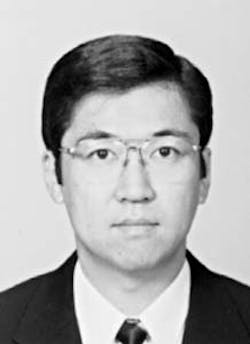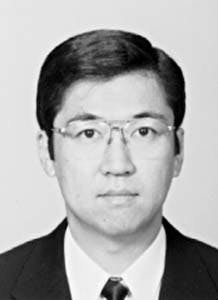JAPANESE REFINER SOLVES PROBLEMS IN RESID DESULFURIZATION UNIT
Hiroki Koyama, Eiichi Nagai, Hidenobu Torii, Hideaki Kumagai
Japan Energy Corp.
Kurashiki, Okayama, Japan
In commercial trials at its Mizushima, Japan, refinery, Japan Energy Corp. found that improved liquid distribution in the resid desulfurization unit catalyst bed prevented the formation of hot spots.
In addition, use of an appropriate catalyst combination prevented pressure-drop increase.
Results of other testing indicated that controlling the residue conversion in each bed may minimize coke deactivation in the last bed.
These solutions have enabled Japan Energy to maximize catalyst utilization in the fixed-bed reactor system and to increase cycle length to 6 months.
This first article in a two-part series describes the problems experienced in the unit and outlines proposed solutions. The second article will present the results of the operational changes undertaken at the Mizushima refinery.
BACKGROUND
Most of the residue hydrodesulfurization (HDS) units in Japan were built between the late 1960s and early 1970s to produce low-sulfur fuel oil. A decrease in domestic demand for fuel oil, however, has made it necessary for Japanese refiners to upgrade residue to more valuable products such as gasoline and middle distillates.
The Mizushima refinery first implemented high-con-version operation on vacuum residue in its conventional resid HDS unit to produce more middle distillates and reduce fuel oil viscosity. The viscosity reduction saves valuable light gas oil (LGO), which is used to adjust fuel oil viscosity.
The new operating mode revealed characteristic problems of fixed-bed reactors, such as hot spots and pres-sure-drop buildup.
Japan Energy conducted analyses of the catalysts used in commercial resid HDS reactors. Cold-flow model tests also were performed to determine the causes of hot spots and pressure-drop buildup, and to find appropriate solutions to the problems.
There has been very little literature available discussing these problems quantitatively. Jaffe described hot spot phenomena mathematically for a gas-phase, fixed-bed reactor (assuming a localalized region of flow disturbance).1 But Jaffe discussed no cause of the flow disturbance.
Shah suggested the use of a Darcy-type equation to predict catalyst bed pressure-drop buildup caused by plugging with solid deposits.2 But Shah mentioned no correlation for the solid deposition rate.
Another characteristic problem of fixed-bed reactors is catalyst deactivation caused by coke formation. Many researchers have worked on understanding and modeling the deactivation of residue HDS catalysts. Most of them, however, studied catalyst deactivation in isothermal bench-scale reactors.3-5
Very few publications discuss optimum utilization of residue catalysts in adiabatic commercial reactors. Additional trials at the Mizushima refinery involved controlling catalyst deactivation.
PROCESS DESCRIPTION
The Mizushima resid HDS unit is the first commercial unit of its kind designed by Gulf Oil Co. It was constructed at the refinery in 1970.
The unit was equipped with two parallel, single-stage reactors. The reactors were designed to process 27,760 b/sd of Kuwait atmospheric residue and produce fuel oil containing 1.0 wt % sulfur. The catalyst replacement cycle was intended to be 6 months.
In 1980, the unit was redesigned to process a mixture of 50% atmospheric resid and 50% vacuum resid from Middle Eastern crude oil. Because running more vacuum resid meant increased processing difficulty and higher metal concentrations, Japan Energy had to reduce the space velocity and increase the catalyst volume in the unit.
As a result, a new reactor was added in each train, increasing feed capacity by 19,000 b/sd.
In 1981, to increase residue conversion, Japan Energy began high-temperature operation of the unit (previously, the operating mode was designed to maintain constant product sulfur content).
Fig. 1(39317 bytes) shows the feedstock variations after remodeling the unit.
Since the operational change, it has been necessary to process as much vacuum residue as possible in the residue HDS unit. As a result, by 1985, the unit was processing almost 100% vacuum residue (Fig. 1) (39317 bytes).
The API gravity of the feedstock also has decreased continuously since the remodeling. Japan Energy developed demetallization and desulfurization catalysts, which have greatly contributed to increasing the ratio of vacuum residue beyond the design.
PROCESS FLOW
Fig. 2 (110802 bytes) shows a simplified process flow diagram of the resid HDS unit.
The feed oil is combined with recycle gas before being heated. The unit has two parallel, high-pressure systems between the oil/gas mixing points and the recycle-gas trim coolers. Each train has two-stage reactors, each of which consists of two catalyst beds.
After the remodeling, the original air coolers on the reactor effluent lines were replaced with low-pressure steam generators. The goal of this change was to prevent plugging caused by heavy materials and corrosion caused by salt deposits in the tubes.
Light hydrocarbon gases are removed in the naphtha contactor to maintain hydrogen purity. Hydrogen sulfide is removed in the diisopropanolamine (DIPA) absorber.
The product oil is separated in the fractionator into naphtha, LGO, and residue.
After the remodeling, a steam generator was added between the feed/product heat exchangers and the product-fuel-oil air cooler. This replacement was made because increasing the ratio of vacuum residue increased feed temperature and, consequently, product fuel oil temperature.
The product naphtha is fed to a catalytic reformer after hydrotreating. The gas oil is not used as diesel oil but as A- type fuel oil because of a color problem. The product residue becomes a main component of fuel oil and is used as part of the feedstock for a delayed coker.
CURRENT OPERATION
Since the refinery began operation on heavy crudes, the average crude oil API gravity is about 28 - the lowest among Japanese refineries. About 80% of the crude oil comes from the Middle East and most of its vacuum residue goes to either the residue HDS unit or the coker.
Tables 1 (10592 bytes) and 2 (16099 bytes) show typical properties of the resid HDS unit feedstock and product fuel oil. The samples were taken during the middle of the run.
The operating cycle is limited by the product sulfur specification. Within a few weeks after a run begins, the reactor temperature has increased enough to convert vacuum residue to low-viscosity fuel oil.
The cycle normally is started with atmospheric residue feed, which is gradually replaced with vacuum residue as the temperature increases. After that, the temperature is increased to compensate for a gradual decrease in the residue conversion activity of the catalyst.
Because HDS activity decreases faster than residue conversion activity, the product sulfur content increases with time.
HOT SPOTS
A hot spot is defined as localized high temperatures in a catalyst bed. In the Mizushima refinery's commercial reactors, bed temperatures are measured at different levels using thermocouples in three parallel, vertical wells.
A hot spot usually occurs during the middle of a run near the center of the lower part of the first bed. The lack of temperature increase in the second bed suggests that the high- temperature region is small.
Japan Energy assumes that a hot spot occurs in a localized region of low liquid flow. A decrease in liquid flow rate increases the rate of exothermic reactions such as hydrogenation and hydro-cracking, thus increasing heat release. The large heats of reaction further increase the reaction rates, ultimately leading to a hot spot.
A composite catalyst sample was taken from each of 13 regions at different bed depths after a hot spot was observed. Figs. 3 (30135 bytes) and 4 (29303 bytes) show the radial distribution of, respectively, coke and metal deposits on the catalyst at various bed depths.
Coke and metals were uniformly distributed on the catalyst at the top of the bed. The amount of coke in the center of the bed, however, increased with bed depth, while the relative amount of metals decreased. This pattern suggests the liquid flow rate declined in the center of the lower part of the bed, where the hot spot was observed.
The reason for this decline is that a decrease in liquid flow increases the conversion rate for heavy molecules thus producing more coke and decreasing metal accumulation.
Because the hot spot occurred during the middle of the run, however, this low liquid flow region was believed to be formed gradually during the run. The authors conclude that the initial liquid maldistribution caused the hot spot.
MALDISTRIBUTION CAUSES
Japan Energy conducted cold-flow model experiments in an air-water/glycerin system to investigate the causes of liquid maldistribution in the first bed.
The apparatus used was a 30-cm ID acrylic column equipped with a liquid distributor at the top and a liquid collector with 33 compartments at the bottom. In this system, the bed depth can be varied by combining short pipes.
Liquid distribution at a given bed depth was estimated by measuring the volume of liquid passing through each compartment of the collector during a given period. Japan Energy examined the effects on liquid distribution of gas and liquid velocity, liquid viscosity, catalyst shape, and catalyst packing method.
Table 3 (13714 bytes) lists the variables and parameters used in these experiments. Increasing both liquid velocity and viscosity improved liquid distribution slightly. Gas flow rate, however, did not influence liquid distribution.
Three methods of catalyst loading were tested:
- Scattering particles uniformly onto the bed using special
equipment maintained a fairly flat bed surface during
packing.
- Dropping the particles onto the center of the bed through
a tube formed a convex bed surface.
- Dropping the catalyst along the inner wall formed a
concave bed surface.
When the uniform scattering method is used, most of the catalyst particles lie horizontally. When the other two methods are used, the particles tend to lie parallel to the inclined bed surface.
After packing the particles, the convex and concave bed surfaces were flattened. Fig. 5 (30387 bytes) shows the radial liquid distribution for the three methods of catalyst loading. Extruded trilobe catalysts were used in these tests.
Liquid distribution was uniform when using the catalyst- loading procedure that maintains a flat bed surface. Liquid flow was faster near the wall, however, when using the procedure that forms a convex bed surface. Flow was faster in the center for the method that forms a concave bed surface.
These results indicate that liquid flows along the slope of the bed surface formed during catalyst packing. The authors conclude, therefore, that liquid has a tendency to flow along the particle orientation as illustrated in Fig. 6 (72290 bytes).
Fig. 7 (30541 bytes) shows the effect of catalyst shape on radial liquid distribution. These particles were packed so that a convex bed surface was formed.
The trilobe catalyst showed the fastest liquid flow near the wall. The same tendency also was observed for quadrilobe catalyst. It was surprising, however, that cylindrical particles produced liquid distribution as good as that of the spherical particles, which have no particle orientation.
The authors presume that the "pleats" along shaped particles like trilobe catalysts may cause the liquid to flow along the particle orientation.
Japan Energy had used the so-called sock-loading method in this unit to produce higher voidage in the first bed. In sock loading, catalysts are placed in the reactor using a flexible hose.
When the catalyst particles are dropped in the center of the bed in this manner, they flow toward the reactor shell and form a sloped or convex surface. The results of the cold-flow model tests showed that this slope makes liquid flow preferentially near the wall of the reactor.
Japan Energy also used shaped catalysts, such as trilobe and quadrilobe catalysts, in the lower part of the first bed of the unit. This catalyst configuration, shown in Fig. 8 (46210 bytes), was designed to increase the bed voidage and the demetallization rate.
The flow problems experienced in the unit were determined to be caused by the poor loading method and inappropriate choice of catalyst shape. The result was decreased liquid flow in the center of the lower part of the bed at the beginning of the run.
LIQUID DISTRIBUTORS
A good liquid distributor also is important in preventing maldistribution. Part of the existing liquid distributor and liquid flow patterns are shown in the left side of Fig. 9 (94686 bytes).
The distributor comprises a tray and a number of short chimneys. Liquid is collected on the tray and flows onto the bed from the chimneys through small holes on the sides.
A cold-flow model test showed that liquid flow rate from the short chimneys was so sensitive to the liquid level in the tray that it was difficult to achieve uniform liquid distribution. In addition, liquid dispersion from the short chimneys was poor.
As a result, Japan Energy developed a new liquid distributor that enables uniform liquid distribution and good liquid dispersion, as shown in the right side of Fig. 9 (94686 bytes).
Because the new liquid distributor incorporates tall chimneys, it can achieve uniform liquid distribution, even if the tray is inclined. The chimneys have an internal configuration that disperses liquid evenly over the bed.
The cold-flow model test also showed that the liquid distributor only influenced distribution within a limited distance from the bed surface. A good liquid distributor, however, should lower the chance of maldistribution caused by nonuniform deposition of solids in the top of the bed.
Editor's note: Some of the information in this article was presented at the Second International Conference on Catalysts in Petroleum and Petrochemical Industries, Apr. 22-26, in Kuwait. The proceedings of this conference will be published by Elsevier Science B.V., Amsterdam.
REFERENCES
1. Jaffe, S.B., Ind. Eng. Chem. Proc. Des. Dev., Vol. 15, No.3,1976, p. 410. 2. Shah, Y.T., Gas-liquid-solid reactor design, McGraw-Hill,
New York, 1979, p. 189. 3. Tamm, P.W., Harnsberger, H.F., and Bridge, A.G., Ind. Eng.
Chem. Proc. Des. Dev., Vol. 20, No. 2, 1981, p. 262. 4. Johnson, B.G., Massoth, F.E., and Bartholdy, J., AIChE J.,
Vol, 32, No. 12, 1986, p. 1,980. 5. Myers, T.E., and Lee, F.S., AIChE Syrup. Series, Vol. 85,
No. 273, 1989, p. 21.


